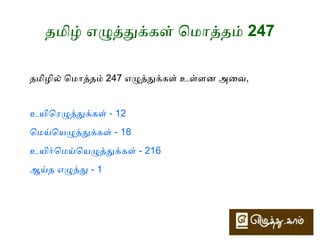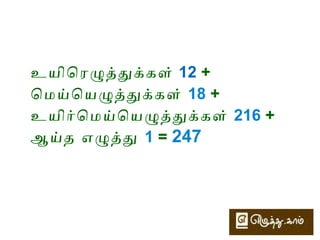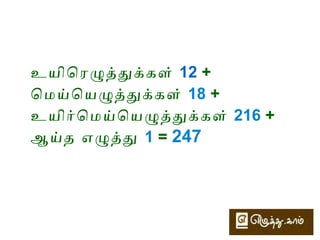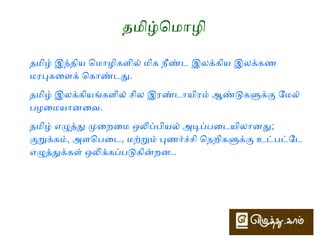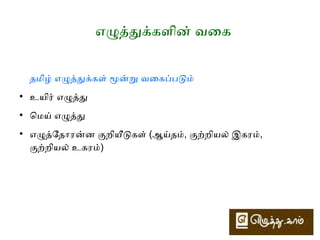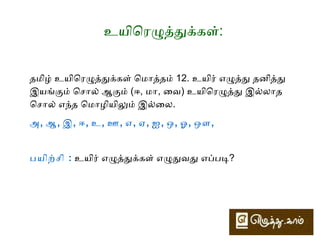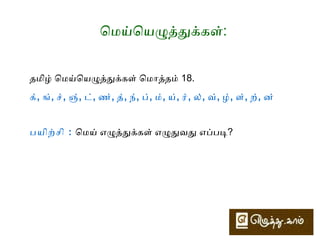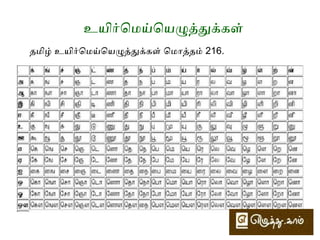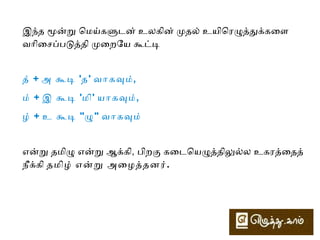தமிழ் எழுத்துக்கள் - Tamil Alphabets
- 2. தமிழ் எழுத்துக்கள் ொமொத்தம் 247 தமிழில் ொமொத்தம் 247 எழுத்துக்கள் உள்ளன அவைவ, உயிொரெழுத்துக்கள் - 12 ொமய்யொயழுத்துக்கள் - 18 உயிர்மொமய்யொயழுத்துக்கள் - 216 ஆய்யத எழுத்து - 1
- 3. உயிொரெழுத்துக்கள் 12 + ொமய்யொயழுத்துக்கள் 18 + உயிர்மொமய்யொயழுத்துக்கள் 216 + ஆய்யத எழுத்து 1 = 247
- 4. தமிழொமொழி தமிழ் இந்திய ொமொழிகளில் மிக நீண்ட இலக்கிய இலக்கண மரெபுகைளக் ொகொண்டது. தமிழ் இலக்கியங்களில் சில இரெண்டொயிரெம் ஆண்டுகளுக்கு ேமல் பழைமயொனைவ. தமிழ் எழுத்து முறைறைமைம ஒலிப்பியல் அவடிப்பைடயிலொனது; குறுக்கம், அவளொபைட, மற்றும் புணர்மச்சி ொநறைமிகளுக்கு உட்பட்ேட எழுத்துக்கள் ஒலிக்கப்படுகின்றைமன..
- 5. எழுத்துக்களின் வகைக தமிழ் எழுத்துக்கள் மூன்று வகைகப்படும் ● உயிர் எழுத்து ● ெமய் எழுத்து ● எழுத்ோதோரன்ன குறியீடுகள் (ஆய்தம், குற்றியல் இகரம், குற்றியல் உகரம்)
- 6. எழுத்துக்களின் வகிோிபு + ெபருகல் எழுத்துக்களின் வகிோிபு ஒவ்வெவகோரு பிறப்பிடமும் (எழுத்து) அவ்வவகிடத்ைதச் சோர்ந்த பல்வோவகறு ஒலியம்கைள குறிக்கும். எழுத்துக்களின் ெபருகல் உயிர்ெமய் எழுத்து
- 7. உயிெரழுத்துக்கள்: தமிழ் உயிெரழுத்துக்கள் ெமோத்தம் 12. உயிர் எழுத்து தனித்து இயங்கும் ெசோல் ஆகும் (ஈ, மோ, ைவக) உயிெரழுத்து இல்வலோத ெசோல் எந்த ெமோழியிலும் இல்வைல. அ, ஆ, இ, ஈ, உ, ஊ, எ, ஏ, ஐ, ஒ, ஓ, ஒள, பயிற்சி : உயிர் எழுத்துக்கள் எழுதுவகது எப்படி?
- 8. ெமய்ெயழுத்துக்கள்: தமிழ் ெமய்ெயழுத்துக்கள் ெமோத்தம் 18. க், ங், ச், ஞ், ட், ண், த், ந், ப், ம், ய், ர், ல், வக், ழ், ள், ற், ன் பயிற்சி : ெமய ்எழுத்துக்கள் எழுதுவகது எப்படி?
- 9. உயிர்மெமெய்யெயழுத்துக்கள் தமெிழ் உயிர்மெமெய்யெயழுத்துக்கள் ெமெொத்தமெ் 216.
- 10. ஆய்யத எழுத்து தமெிழ் ஆய்யத எழுத்து ெமெொத்தமெ் 1. எழுத்து ெபயர் ஃ ஆய்யத எழுத்து
- 11. நம்மெமெொழிக்கு தமெிழ் என்று எப்படி ெபொருள் வந்தது எப்படி? உலக மெொந்தன் முதல் முதலில் பயன்படுத்திய உயிர் ஒலிகள் அ(படர்மக்ைக), இ(தன்னிைல), உ(முன்னிைல) என்பது பொவொணர் கருத்து.
- 12. நம்மொமொழிக்கு தமிழ் என்று எப்படி ொபொருள் வந்தது எப்படி? தமிழின் ொமய் எழுத்துக்களில் வல்லினத்தில் ஒன்றும், ொமல்லினத்தில் ஒன்றும், இடைடையினத்தில் ஒன்றுமொக மூன்று ொமொயழுத்துக்கைள­த் ேதர்ந்ொதடுத்தனர். அவைவ த், ம், ழ் என்பைவ.
- 13. இடந்த மூன்று ொமய்களுடைன் உலகின் முதல் உயிொரழுத்துக்கைள வொிைசைப்படுத்தி முைறையேய கூட்டி த் + அவ கூடி 'த' வொகவம், ம் + இட கூடி 'மி' யொகவம், ழ் + உ கூடி "ழு" வொகவம் என்று தமிழு என்று ஆக்கி, பிறையகு கைடைொயழுத்திலுல்ல உகரத்ைதத் நீக்கி தமிழ் என்று அவைழத்தனர்.


